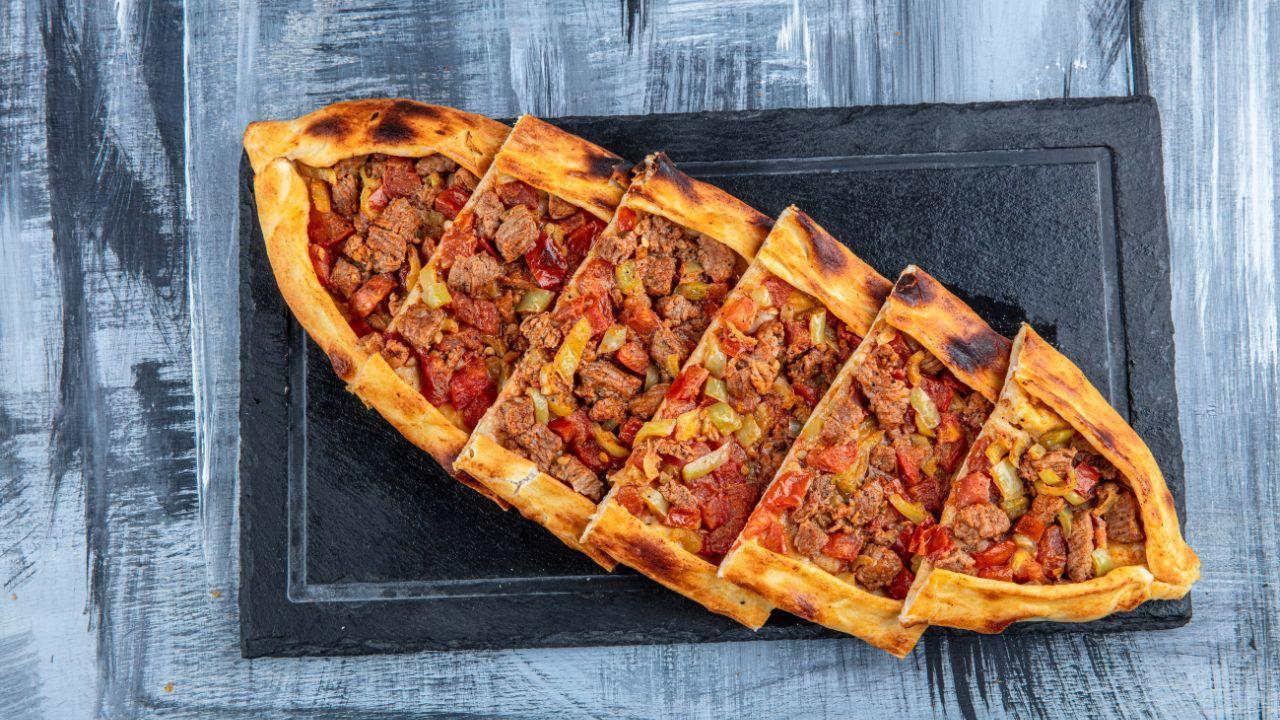
Post by: Kanchan Chandel
In the heart of Turkey lies a culinary gem that has captivated food enthusiasts around the world – Kuzina Pide. This traditional Turkish flatbread, often referred to as the "Turkish pizza," offers a unique and delightful experience that goes beyond your typical slice. Let’s delve into the rich history, diverse varieties, and irresistible appeal of Kuzina Pide.
Pide, pronounced "pee-deh," has long been a beloved staple in Turkish cuisine, with roots that reach deep into history. This delightful flatbread, often compared to pizza, originates from the Black Sea region of Turkey. The story of pide begins centuries ago when local bakers started experimenting with simple ingredients to create hearty meals.
The Black Sea region, known for its fertile lands and abundant harvests, provided the perfect backdrop for the creation of pide. Early bakers used locally sourced wheat to make the dough, which they topped with a variety of ingredients found in their surroundings. Over time, the method of baking pide evolved, incorporating techniques passed down through generations. Bakers began using stone ovens, which imparted a distinct, smoky flavor to the bread, enhancing its appeal.
As trade routes expanded and people migrated, pide spread beyond the Black Sea region, adapting to the tastes and ingredients of different areas in Turkey. Each region added its twist to the traditional recipe. For instance, the coastal areas introduced seafood toppings, while the central parts of Turkey, known for their rich pastures, added various types of meat and cheese.
The versatility of pide made it a popular dish among different social classes. It was simple enough for everyday meals but could be made elaborate for special occasions. Whether topped with minced meat, vegetables, or cheeses, pide became a symbol of Turkish culinary ingenuity.
Throughout the centuries, pide has maintained its status as a cultural icon in Turkey. It is often enjoyed during family gatherings, festive celebrations, and communal feasts. The act of sharing a pide is seen as a gesture of hospitality and togetherness, embodying the warmth and generosity of Turkish culture.
Today, pide continues to be a beloved dish, not just in Turkey but around the world. Modern chefs experiment with new toppings and flavors, keeping the tradition alive while appealing to contemporary palates. Despite these innovations, the essence of pide remains the same – a simple, yet incredibly satisfying flatbread that brings people together.
In summary, the history of pide is a testament to the rich culinary traditions of Turkey. From its humble beginnings in the Black Sea region to its widespread popularity today, pide has remained a delicious and versatile dish that reflects the diverse and vibrant culture of its homeland.
Kuzina Pide offers a wide range of flavors, each one special and distinct. Let’s take a closer look at some of the most popular types:
This traditional pide is a favorite among meat lovers. It features a delicious mixture of minced lamb or beef, combined with finely chopped onions, juicy tomatoes, and vibrant peppers. These ingredients are mixed with a blend of traditional Turkish spices, creating a savory filling that is both hearty and flavorful. The minced meat is spread evenly over the dough, ensuring every bite is packed with taste.
Cheese enthusiasts will fall in love with Peynirli Pide. This version is generously topped with a variety of Turkish cheeses, such as tangy feta, creamy kasar, or a blend of both. The cheeses melt beautifully in the oven, resulting in a gooey, savory topping that is simply irresistible. The richness of the cheese is perfectly balanced with the crispy crust of the pide.
For those who enjoy a bit of spice, Sucuklu Pide is the way to go. Sucuk, a flavorful Turkish sausage, is the star of this pide. The sausage is sliced thin and spread over the dough, often accompanied by melted cheese and sometimes fresh vegetables like tomatoes or peppers. The spicy, garlicky flavor of the sucuk provides a delightful contrast to the creamy cheese, making this pide a true taste sensation.
Ispanakli Pide is a great choice for those looking for a healthier option without compromising on taste. This version features a filling of fresh spinach, which is often mixed with cheese for added flavor. A touch of garlic and dill enhances the aroma and taste, creating a delightful combination that’s both nutritious and delicious. The spinach provides a fresh, earthy flavor that pairs perfectly with the crispy dough.
Vegetarian Pide is perfect for those who prefer a lighter meal but still want something satisfying. This version is loaded with a variety of fresh vegetables, such as juicy tomatoes, crisp peppers, and earthy mushrooms. The vegetables are seasoned and spread over the dough, creating a colorful and flavorful topping. Each bite offers a burst of freshness and a satisfying crunch.
Crafting the perfect Kuzina Pide is both an art and a science. It starts with the dough, the foundation of any great pide. The dough must be prepared with care, ensuring the right balance between crispiness and chewiness. Achieving this balance involves precise measurements and the right ingredients – typically flour, water, yeast, and a pinch of salt.
Once the dough is mixed, it needs to rest and rise, allowing the yeast to work its magic. This step is crucial as it gives the dough its light, airy texture. After it has risen, the dough is kneaded again and then rolled out into a thin, oval shape. The distinctive boat-like form of the pide is created by folding the edges over slightly and pinching the ends. This shape not only looks appealing but also helps to keep the toppings in place during baking.
Choosing the right toppings is where creativity comes into play. Classic options include minced meat, various cheeses, fresh vegetables, or spicy sausages. Each topping is carefully spread over the dough, ensuring an even distribution so that every bite is full of flavor.
The real magic happens in the oven. Traditionally, Kuzina Pide is baked in a stone oven, which can reach extremely high temperatures. This high heat is essential for achieving the perfect pide – it gives the crust a lovely crispness while keeping the inside soft and tender. If you don’t have a stone oven at home, a pizza stone in a conventional oven can work quite well.
As the pide bakes, the toppings meld together, releasing their flavors and aromas. The high heat caramelizes the edges of the dough and any exposed toppings, adding a delightful crunch and depth of flavor.
The final touch is often a drizzle of high-quality olive oil, which adds a rich, fruity note and a beautiful sheen to the finished dish. A sprinkling of fresh herbs, such as parsley or oregano, can also enhance the flavor and presentation, making the pide not only taste delicious but look enticing as well.
Kuzina Pide is best enjoyed fresh out of the oven, when the crust is still crisp and the toppings are hot and bubbly. Pair it with a simple salad, a bowl of tangy yogurt, or a cup of traditional Turkish tea for a complete meal. Whether you're making it at home or ordering from a Turkish restaurant, the process of creating and savoring Kuzina Pide is a delightful culinary journey that celebrates the flavors and traditions of Turkey.
Kuzina Pide is more than just a dish; it's a symbol of Turkish hospitality and tradition. In Turkey, sharing a pide with family and friends is a cherished practice, particularly during special occasions and gatherings. This flatbread, with its warm and inviting aroma, naturally brings people together.
In Turkish culture, food is not just sustenance; it's an expression of love and community. When you walk into a Turkish home, you'll likely be offered tea and something to eat, often accompanied by stories and laughter. Kuzina Pide perfectly embodies this spirit of generosity and togetherness. Its simple yet rich flavors reflect the heart of Turkish cuisine, which is always about more than just the ingredients—it's about the shared experience.
During festive times, like holidays or family celebrations, preparing and sharing pide is a beloved tradition. Families gather to knead the dough, prepare the toppings, and bake the pides together. This communal cooking activity strengthens bonds and creates lasting memories. The sight of a beautifully baked pide coming out of the oven, with its golden crust and savory fillings, brings smiles and eager anticipation.
Eating pide in Turkey is also a social activity. Whether in a bustling city or a quiet village, you'll find people enjoying pides in local bakeries and restaurants. It's common to see friends and families sitting around a table, tearing off pieces of pide, and savoring the moment. This act of sharing a meal emphasizes the Turkish values of warmth, connection, and hospitality.
Moreover, Kuzina Pide showcases the diversity within Turkish cuisine. Different regions have their own unique versions of pide, incorporating local ingredients and flavors. This variety not only highlights the culinary richness of Turkey but also the importance of regional traditions in shaping national identity.
In essence, Kuzina Pide is more than a delicious dish—it's a symbol of Turkish life and a reminder of the importance of sharing and community. Whether you're enjoying it at a festive gathering or a casual meal with friends, Kuzina Pide connects people through the universal language of good food.
There's something special about savoring Kuzina Pide, especially when it's piping hot and fresh from the oven. The delightful combination of crispy crust and flavorful toppings is best appreciated when the pide is at its freshest.
To enhance the experience, consider pairing your Kuzina Pide with a few simple, yet complementary sides. A crisp, fresh salad can add a refreshing contrast to the warm, savory flavors of the pide. Opt for a Mediterranean-style salad with cucumbers, tomatoes, olives, and a light vinaigrette to keep things light and vibrant.
Another great companion to Kuzina Pide is a bowl of tangy yogurt. In Turkey, it’s common to serve yogurt as a side dish, often seasoned with garlic, cucumber, and a touch of mint to create a cooling tzatziki-like dip. The creamy texture and slight acidity of the yogurt perfectly balance the rich flavors of the pide.
For those who enjoy a traditional touch, pairing Kuzina Pide with a cup of Turkish tea can elevate the dining experience. The robust and slightly bitter flavor of the tea acts as a wonderful palate cleanser, allowing you to fully appreciate each bite of the pide. Turkish tea, known as çay, is typically served in small, tulip-shaped glasses, and drinking it slowly is part of the cultural experience.
Whether you're enjoying Kuzina Pide at a cozy Turkish restaurant or recreating it in your own kitchen, its versatility and taste ensure it’s always a crowd-pleaser. Making it at home can be a fun and rewarding experience, too. You can experiment with different toppings and create your own signature version of this beloved dish.
So, next time you're in the mood for something comforting yet a bit exotic, reach for Kuzina Pide. Its rich history, diverse flavors, and the simple joy of sharing it with loved ones make it more than just a meal – it’s a culinary journey to the heart of Turkey.
Summary
Kuzina Pide, often referred to as the "Turkish pizza," is a beloved traditional flatbread from Turkey that has captured the hearts of food enthusiasts globally. Originating in the Black Sea region, Pide boasts a rich history and has evolved to include diverse varieties such as Kiymali (minced meat), Peynirli (cheese), Sucuklu (sausage), Ispanakli (spinach), and vegetarian options. The art of making Pide involves crafting a perfect dough, selecting the right toppings, and baking it in a stone oven for optimal flavor and texture. Enjoying Pide fresh from the oven, paired with complementary sides like crisp salad, tangy yogurt, or Turkish tea, enhances the culinary experience. Beyond its delicious taste, Pide is a symbol of Turkish hospitality and tradition, often enjoyed during family gatherings and festive celebrations.
This article is presented by DXB News Network for informational purposes only. The content is based on traditional recipes and cultural practices related to Kuzina Pide. Readers are encouraged to explore and enjoy the culinary traditions of Turkey with respect and authenticity. The views and opinions expressed in this article do not necessarily reflect those of DXB News Network.
Kuzina Pide is a traditional Turkish flatbread often likened to a "Turkish pizza." It features a boat-shaped dough base topped with various ingredients like minced meat, cheese, spinach, or sausage, baked to perfection.
While similar in appearance, Kuzina Pide differs from pizza in dough texture and toppings. The dough is thicker and softer, and the toppings often include unique Turkish ingredients and spices.
Popular varieties include Kiymali Pide (minced meat), Peynirli Pide (cheese), Sucuklu Pide (sausage), Ispanakli Pide (spinach), and vegetarian options. Each variety offers a distinct flavor profile.
Kuzina Pide is typically served hot from the oven, accompanied by sides like fresh salad, tangy yogurt, or Turkish tea. It’s enjoyed during family gatherings, celebrations, and as a communal meal.
Yes, Kuzina Pide can be made at home using basic ingredients like flour, yeast, water, and a variety of toppings. Baking it in a hot oven or using a pizza stone helps achieve the authentic texture and flavor.
#trending #latest #KuzinaPide #TurkishPizza #TurkishCuisine #Foodie #Flatbread #FoodCulture #TurkishFood #DeliciousDishes #PideVarieties #CulinaryTraditions #breakingnews #worldnews #headlines #topstories #globalUpdate #dxbnewsnetwork #dxbnews #dxbdnn #dxbnewsnetworkdnn #bestnewschanneldubai #bestnewschannelUAE #bestnewschannelabudhabi #bestnewschannelajman #bestnewschannelofdubai #popularnewschanneldubai

Dubai Chamber sets up Slovak Council to boost trade, 134 firms join in 2024, non-oil trade hits AED 3.4B, up 38% from 2023...Read More.

Khalifa University climbs to 37th in Asia in THE 2025, staying top in UAE. It leads in research, innovation, and solving real-world challenges....Read More.














Lashkar Terrorist Killed, 2 Soldiers Injured in Bandipora Encounter
A Lashkar-e-Taiba terrorist was killed and 2 soldiers injured in an ongoing encounter in Bandipora,

Now You See Me: Now You Don’t Film in Abu Dhabi with Stars
"Lionsgate’s 'Now You See Me: Now You Don’t' films iconic Abu Dhabi locations with stars like Jesse

Chinese Astronauts To Launch For Space Station
China’s Shenzhou-20 mission launches 3 astronauts to its space station. Crew to stay 6 months doing

Arsenal Draws 2-2 With Crystal Palace, Liverpool One Point Away
Arsenal's 2-2 draw with Crystal Palace leaves Liverpool one point away from winning the Premier Leag

Abu Dhabi to host global One Run race on May 24, 2025
Abu Dhabi will hold the One Run on Hudayriyat Island with races for all ages. Runners from 30+ count